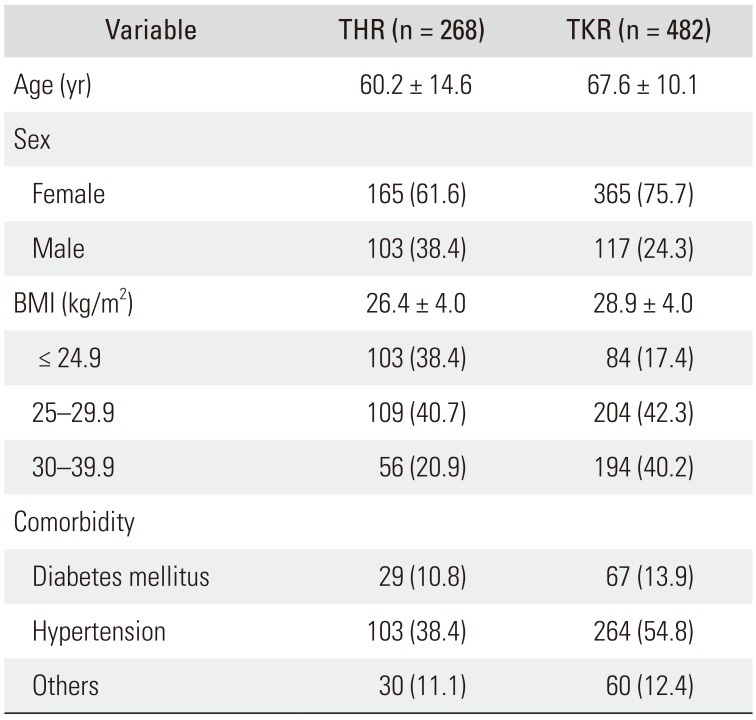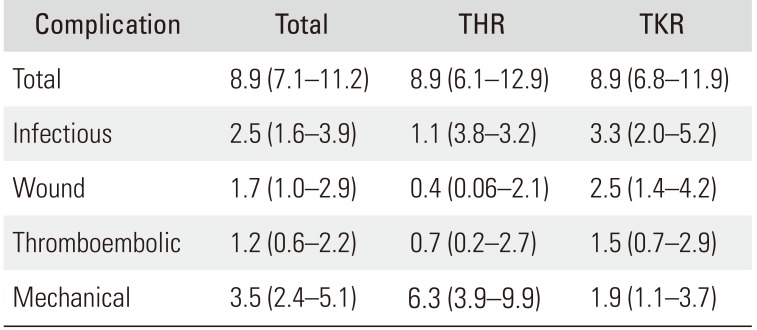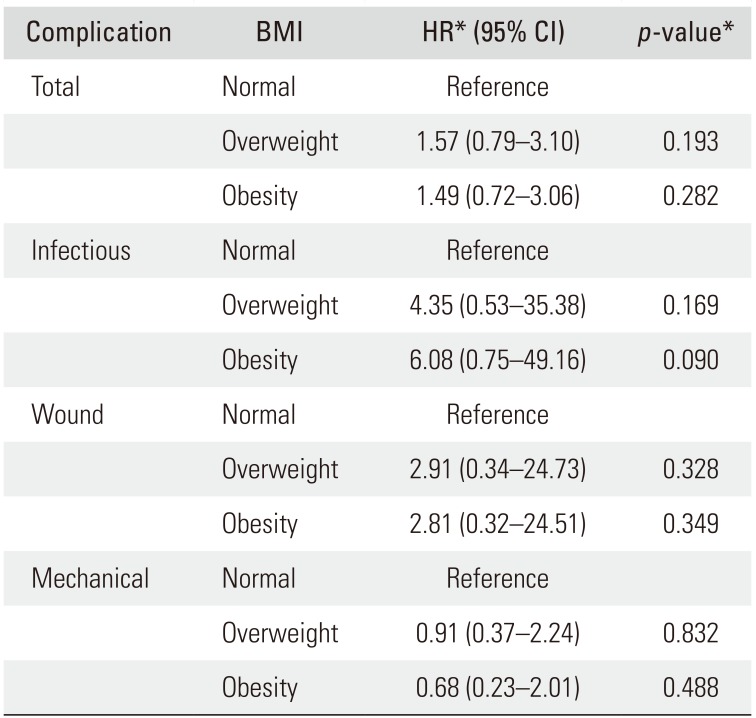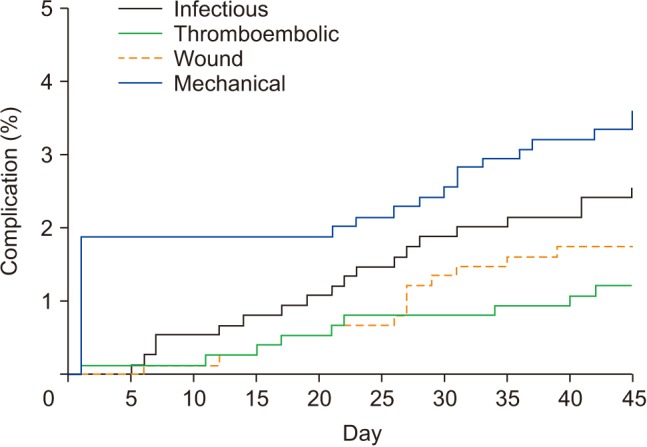1. Busato A, Roder C, Herren S, Eggli S. Influence of high BMI on functional outcome after total hip arthroplasty. Obes Surg. 2008; 18(5):595–600. PMID:
18369684.

2. Dowsey MM, Choong PF. Obese diabetic patients are at substantial risk for deep infection after primary TKA. Clin Orthop Relat Res. 2009; 467(6):1577–1581. PMID:
18841430.

3. Jain NB, Guller U, Pietrobon R, Bond TK, Higgins LD. Comorbidities increase complication rates in patients having arthroplasty. Clin Orthop Relat Res. 2005; (435):232–238.

4. Winiarsky R, Barth P, Lotke P. Total knee arthroplasty in morbidly obese patients. J Bone Joint Surg Am. 1998; 80(12):1770–1774. PMID:
9875934.

5. Suleiman LI, Ortega G, Ong'uti SK, et al. Does BMI affect perioperative complications following total knee and hip arthroplasty? J Surg Res. 2012; 174(1):7–11. PMID:
21816426.

6. Wang JL, Gadinsky NE, Yeager AM, Lyman SL, Westrich GH. The increased utilization of operating room time in patients with increased BMI during primary total hip arthroplasty. J Arthroplasty. 2013; 28(4):680–683. PMID:
23142454.

7. Lubbeke A, Zingg M, Vu D, et al. Body mass and weight thresholds for increased prosthetic joint infection rates after primary total joint arthroplasty. Acta Orthop. 2016; 87(2):132–138. PMID:
26731633.
8. Issa K, Harwin SF, Malkani AL, Bonutti PM, Scillia A, Mont MA. Bariatric orthopaedics: total hip arthroplasty in superobese patients (those with a BMI of ≥50 kg/m2). J Bone Joint Surg Am. 2016; 98(3):180–185. PMID:
26842407.

9. Alvi HM, Mednick RE, Krishnan V, Kwasny MJ, Beal MD, Manning DW. The effect of BMI on 30 day outcomes following total joint arthroplasty. J Arthroplasty. 2015; 30(7):1113–1117. PMID:
25683294.

10. Wallace G, Judge A, Prieto-Alhambra D, de Vries F, Arden NK, Cooper C. The effect of body mass index on the risk of post-operative complications during the 6 months following total hip replacement or total knee replacement surgery. Osteoarthritis Cartilage. 2014; 22(7):918–927. PMID:
24836211.
11. Moran M, Walmsley P, Gray A, Brenkel IJ. Does body mass index affect the early outcome of primary total hip arthroplasty? J Arthroplasty. 2005; 20(7):866–869. PMID:
16230236.

12. Patel AD, Albrizio M. Relationship of body mass index to early complications in hip replacement surgery: study performed at Hinchingbrooke Hospital, Orthopaedic Directorate, Huntingdon, Cambridgeshire. Int Orthop. 2007; 31(4):439–443. PMID:
16960720.
13. Jiganti JJ, Goldstein WM, Williams CS. A comparison of the perioperative morbidity in total joint arthroplasty in the obese and nonobese patient. Clin Orthop Relat Res. 1993; (289):175–179. PMID:
8472410.

14. Deshmukh RG, Hayes JH, Pinder IM. Does body weight influence outcome after total knee arthroplasty? A 1-year analysis. J Arthroplasty. 2002; 17(3):315–319. PMID:
11938508.

15. Perka C, Arnold U, Buttgereit F. Influencing factors on perioperative morbidity in knee arthroplasty. Clin Orthop Relat Res. 2000; (378):183–191.

16. Wagner ER, Kamath AF, Fruth KM, Harmsen WS, Berry DJ. Effect of body mass index on complications and reoperations after total hip arthroplasty. J Bone Joint Surg Am. 2016; 98(3):169–179. PMID:
26842406.

17. Haverkamp D, Klinkenbijl MN, Somford MP, Albers GH, van der Vis HM. Obesity in total hip arthroplasty: does it really matter? A meta-analysis. Acta Orthop. 2011; 82(4):417–422. PMID:
21657972.
18. Felson DT. Weight and osteoarthritis. Am J Clin Nutr. 1996; 63(3 Suppl):430S–432S. PMID:
8615335.

19. Namba RS, Paxton L, Fithian DC, Stone ML. Obesity and perioperative morbidity in total hip and total knee arthroplasty patients. J Arthroplasty. 2005; 20(7 Suppl 3):46–50. PMID:
16214002.

20. Selvan D, Donnelly T, McNicholas M. Management of complications of primary total knee replacement. Orthop Trauma. 2013; 27(6):355–363.
21. Nutt JL, Papanikolaou K, Kellett CF. Complications of total hip arthroplasty. Orthop Trauma. 2013; 27(5):272–276.
22. Liu W, Wahafu T, Cheng M, Cheng T, Zhang Y, Zhang X. The influence of obesity on primary total hip arthroplasty outcomes: a meta-analysis of prospective cohort studies. Orthop Traumatol Surg Res. 2015; 101(3):289–296. PMID:
25817907.

23. Singh JA, Jensen MR, Harmsen SW, Lewallen DG. Are gender, comorbidity, and obesity risk factors for postoperative periprosthetic fractures after primary total hip arthroplasty? J Arthroplasty. 2013; 28(1):126–131. PMID:
22552223.

24. Maradit Kremers H, Lewallen LW, Mabry TM, Berry DJ, Berbari EF, Osmon DR. Diabetes mellitus, hyperglycemia, hemoglobin A1C and the risk of prosthetic joint infections in total hip and knee arthroplasty. J Arthroplasty. 2015; 30(3):439–443. PMID:
25458090.

25. Han HS, Kang SB. Relations between long-term glycemic control and postoperative wound and infectious complications after total knee arthroplasty in type 2 diabetics. Clin Orthop Surg. 2013; 5(2):118–123. PMID:
23730475.

26. Lenguerrand E, Beswick AD, Whitehouse MR, Wylde V, Blom AW. Outcomes following hip and knee replacement in diabetic versus nondiabetic patients and well versus poorly controlled diabetic patients: a prospective cohort study. Acta Orthop. 2018; 89(4):399–405. PMID:
29757058.








 PDF
PDF ePub
ePub Citation
Citation Print
Print



 XML Download
XML Download